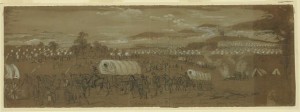After a morning retreat on 19 Oct. 1864 by Union troops, including eight companies of my ancestor Pvt. Arthur Bull’s 6th New York Heavy Artillery regiment, Confederate Lt. Gen. Jubal Early mistakenly assumed that the Battle of Cedar Creek was over.
Believing the Confederates had won, he called a halt to their advance down the Shenandoah Valley — a fateful move that allowed the Union Army to regroup.

As famished Confederate troops helped themselves to still-warm breakfasts from Union campfires, Gen. Philip Sheridan arrived at the front on horseback — just in time to turn a rout into a Union counter-offensive.
I’m not sure where my great, great grandfather’s 6th NYHA Co. L was stationed that day — at the front or guarding a supply train. But either way, Arthur was on duty in the Valley at a crucial juncture in the Civil War.
During the fierce firefight, Pvt. Orson L. Reynolds of 6th NYHA Co. M was stationed with a Union supply train. He described his experience in a letter to his wife dated 28 Oct. 1864:
On the day the battle was secured between Gen’l Sheridan and Early [I was] some 12 miles from Winchester and within plain hearing distance for Artillery…Co. M and two others were here at the time and did not participate in the action. Had I gone to the regiment one day sooner I should probably have been in it.
There were no railroads running through the Shenandoah Valley. The Union Army instead used wagon trains to transport vital supplies to the troops — and they had to be guarded to fend off Confederate raids.
If my ancestor was on train-guard duty during the Battle of Cedar Creek, he may have been among the soldiers at the rear who, wrote Pvt. Reynolds, were eventually drawn into the Union’s battle efforts:
Things looked rather dubious at Winchester on the 19th in the forenoon the waggon [sic] trains came in in great haste besides many straggling soldiers and troops soon began to form in lines about our camp. Soon we were ordered to strike tents and were marched two miles from town and constituted as outer line of Pickets and were ordered to be ready for action at a moments notice.
The fighting raged on all day. Then, in the late afternoon, the Union cavalry and infantry launched a blistering counterattack against the Confederates that sent them running for cover.
After that, the battle really was over, and the Confederate forces were finally driven from the Valley — marking a major turning point in the war just two weeks before the presidential election.
What was the political impact of the Battle of Cedar Creek? What would come next for my great, great grandfather and his Union compatriots? More in the next post.
© 2014 Molly Charboneau. All rights reserved.
